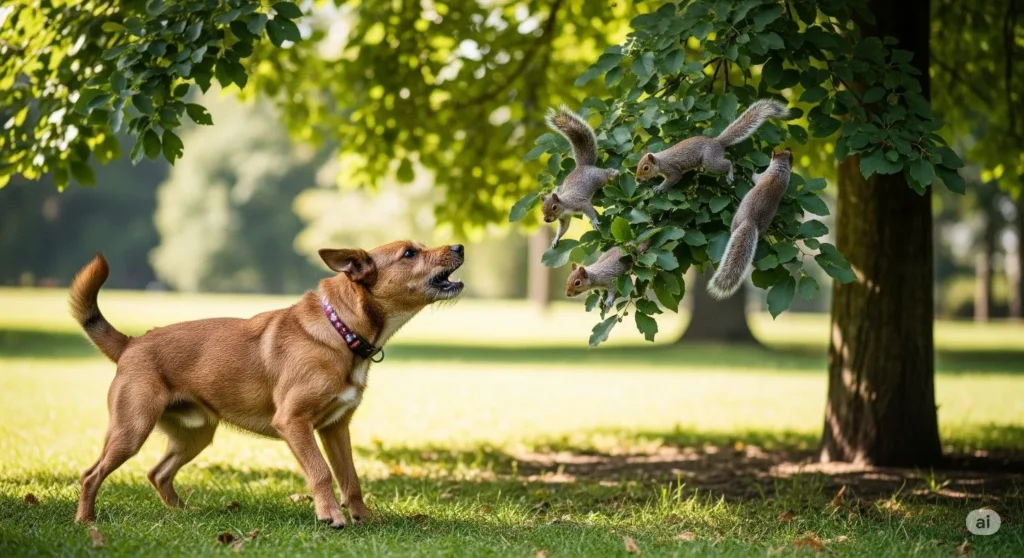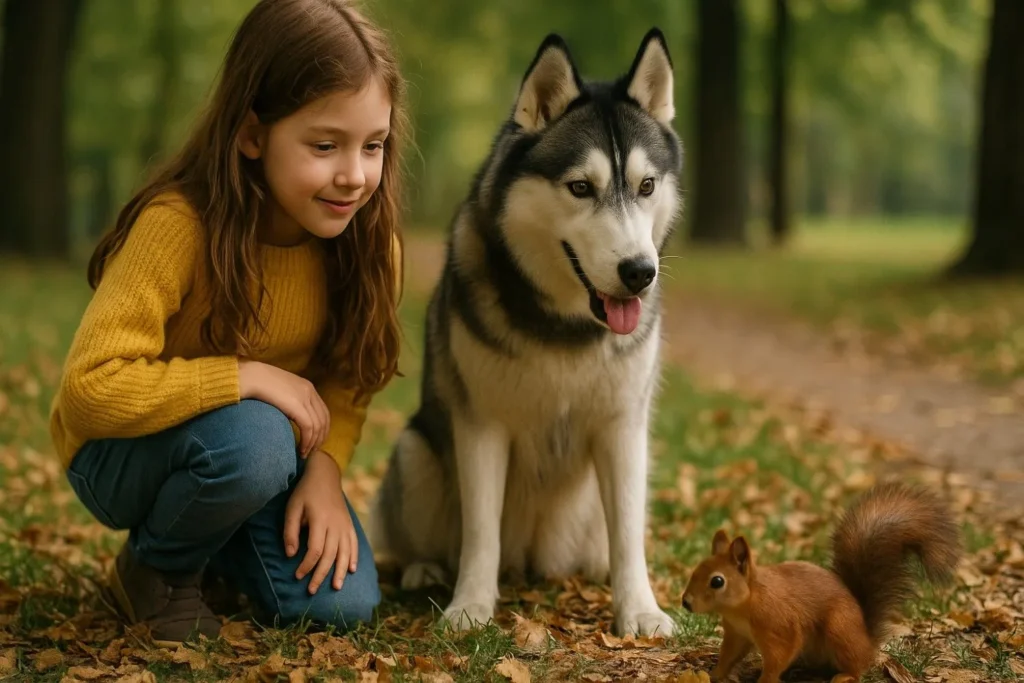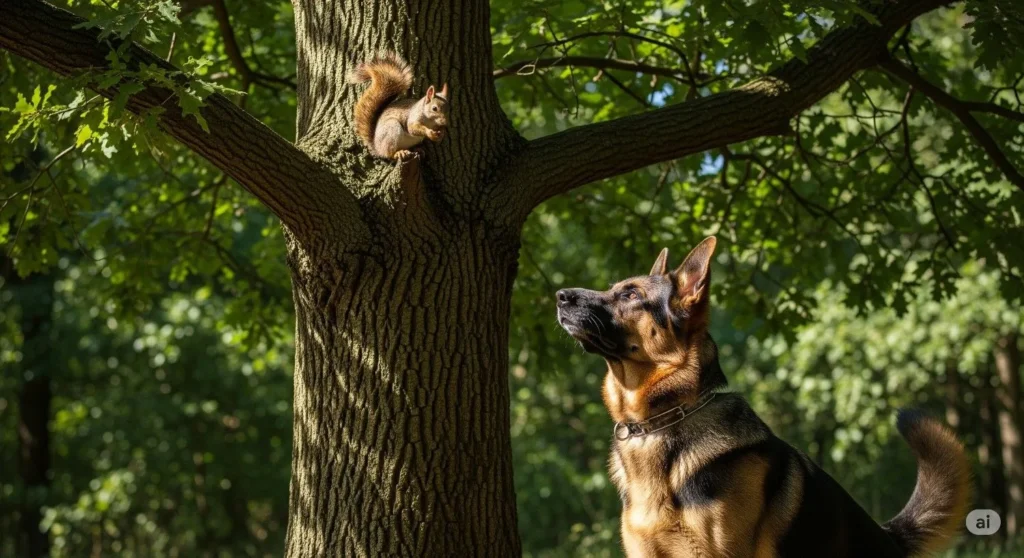Is your peaceful morning shattered by a sudden, frantic barking outburst aimed at an unsuspecting squirrel outside your window? You’re not alone. The sound of that indignant, repetitive “Woof! Woof! Woof!” as your dog gazes intently at the twitching tail of a squirrel can be incredibly frustrating. It’s a common, often exasperating behavior for dog owners, but understanding why your dog barks at squirrels inside, and implementing effective strategies, can bring back harmony to your home.

This guide will dive deep into the fascinating reasons behind this canine obsession and provide actionable steps to manage and ultimately reduce this window-bound drama.
The Instinct Behind the Bark: Understanding the ‘Why’
When your dog transforms into a furry, barking sentinel at the sight of a squirrel, it’s not usually out of malice. Instead, it’s a complex interplay of instinct, frustration, and learned behaviors.
1. The Mighty Prey Drive: It’s in Their DNA
At the core of almost all squirrel-related barking is the prey drive. Dogs, regardless of their breed, are descendants of wolves, and chasing small, fast-moving critters is hardwired into their genetic code. Squirrels are the perfect trigger: they’re quick, unpredictable, and often appear suddenly.
- Observation & Arousal: Your dog spots the movement, their brain registers “prey,” and immediately, a surge of adrenaline kicks in. Their posture might stiffen, ears perk up, and their focus becomes laser-sharp.
- The Chase that Never Was: This is where the indoor aspect comes in. They see the prey, but they are physically prevented from acting on their instinct to chase. This leads to immense frustration. The barking is an outlet for that pent-up energy and unfulfilled desire to pursue. Think of it as their frustrated battle cry.
2. Territoriality and Guarding Instincts
Many dogs have a natural instinct to guard their perceived territory. To your dog, your home and yard are their domain. A squirrel, even a tiny one, can be seen as an intruder.
- Alarm System: The barking serves as an alarm, warning you (the “pack leader”) of the perceived threat. They’re saying, “Hey! There’s something out there that shouldn’t be!”
- Claiming Space: For some dogs, it’s also a way to communicate to the squirrel, “This is my space! Go away!” It’s a form of boundary enforcement, even if ineffective through a pane of glass.
3. Boredom and Lack of Stimulation
If your dog isn’t getting enough physical exercise or mental stimulation, they might be looking for ways to entertain themselves. A squirrel outside the window can become the most exciting event of their day.
- Self-Entertainment: Staring and barking at squirrels can become a self-rewarding behavior. It’s an activity, a way to expend some pent-up energy when there’s nothing else going on.
- Underserved Needs: If a dog’s natural needs for activity, sniffing, problem-solving, and interaction aren’t being met, they’ll find their own outlets – and barking at outdoor critters is a prime candidate.
4. Excitement and Overstimulation
Sometimes, the barking isn’t frustration or guarding; it’s pure, unadulterated excitement. Imagine your dog’s favorite toy suddenly coming to life and dancing just out of reach – that’s often how they view a squirrel.
- Arousal-Based Barking: This type of barking often sounds higher-pitched, more rapid, and accompanied by bouncy body language rather than stiff, territorial stances. They’re just so excited by the sight.
- Escalation: Without intervention, this excitement can quickly escalate into frantic, non-stop barking, especially if the squirrel seems to “respond” by moving or chattering back.
5. Attention Seeking (Sometimes)
While less common as a primary driver for squirrel barking specifically, if barking at squirrels always gets a reaction from you – even a negative one (like yelling or pushing them away) – your dog might learn that this behavior gets your attention.
- Unintended Reinforcement: Any attention can be rewarding for a dog craving interaction. If they learn that barking at squirrels makes you appear, talk to them, or even just look their way, they might continue the behavior to solicit that attention.

My Journey with the Squirrel Sentinel: A Personal Take
I’ve been there. I know the piercing sound of that incessant barking all too well. For years, I’ve dealt with my own dogs barking at squirrels inside, and it’s certainly tested my patience. My Jack Russell Terrier mix, Pip, was a prime offender. For him, I think it was a potent mix of prey drive and frustration. He’d see a squirrel dart across the fence, and he’d launch into this guttural, frantic bark, punctuated by frustrated little leaps.
I remember thinking, “He just wants to get that squirrel so bad! But he can’t, and it’s making him so upset!” It wasn’t just the noise; it was seeing him so agitated, so keyed up. I realized I needed to understand the underlying reasons for his behavior, rather than just getting angry about the noise.
I tried everything at first: yelling “No!”, pulling him away, even trying to clap loudly to scare the squirrels off (which, of course, never worked). Nothing seemed to stick. In fact, I think my reactions often made it worse because he was getting attention for the barking. It was only when I started to understand positive reinforcement and management techniques that I truly began to see a change. I focused on removing the visual trigger first, and then slowly, very slowly, worked on redirection and teaching him alternative behaviors. It took time and consistency, but the calm returned to our home, and to Pip.
Effective Strategies to Stop Window Barking
Now that we understand the “why,” let’s get into the “how.” A multi-faceted approach combining management, training, and enrichment is usually the most effective.
1. Management Strategies: The Immediate Fixes
These strategies aim to reduce or eliminate the trigger, which is the quickest way to reduce barking.
- Block the View: This is often the most impactful first step.
- Blinds or Curtains: Simply closing them during prime squirrel hours (mornings and late afternoons) can make a huge difference.
- Window Film: Static cling window film (frosted, decorative, or one-way privacy film) can block the view while still allowing light in. This is a brilliant solution for windows your dog frequently stares out of.
- Dog-Specific Window Screens/Barriers: Some pet supply companies offer screens or barriers that restrict access to windows or obscure the lower portion of the view.
- Restrict Access: If your dog barks from only one or two specific windows, consider blocking access to those areas with baby gates or by keeping certain doors closed.
- Create a “No-Bark” Zone: Designate a specific area of the house (away from squirrel-prone windows) as a quiet zone, perhaps with their bed and favorite toys.
2. Training & Behavior Modification: Long-Term Solutions
These strategies require consistency and patience but yield lasting results by changing your dog’s emotional response to squirrels. Always use positive reinforcement!
- Teach “Look At That” (LAT) or “Watch Me”: This is a powerful counter-conditioning exercise.
- LAT: When your dog first notices a squirrel (before barking), say “Look at that!” and immediately reward them with a high-value treat for looking at you after looking at the squirrel. The goal is to change their association from “squirrel = bark” to “squirrel = look at human = treat!”
- “Watch Me”: Teach your dog to make eye contact with you on command. When a squirrel appears, command “Watch me” and reward them for shifting their focus to you.
- The “Quiet” Command:
- Let your dog bark 2-3 times at the squirrel.
- Then, calmly say “Quiet” and immediately present a high-value treat to their nose. The moment they stop barking to sniff the treat, say “Good quiet!” and give the treat.
- Gradually increase the duration of silence required before the treat.
- Never reward barking. Only reward silence.
- Redirection and Alternative Behaviors:
- When you see a squirrel, before your dog starts barking, immediately engage them in a different, high-value activity. This could be a quick game of fetch, a puzzle toy, or practicing obedience commands in another room.
- Teach them to go to a designated “mat” or “bed” when they see a squirrel, and reward them heavily for staying there calmly.
- Desensitization (Advanced): This involves gradually exposing your dog to the trigger in a controlled way, starting at a distance where they don’t react, and slowly decreasing the distance while maintaining calm behavior. This is best done with guidance from a professional trainer.
3. Enrichment & Exercise: Addressing Core Needs
A well-exercised and mentally stimulated dog is less likely to engage in nuisance behaviors like excessive barking.
- Increase Physical Exercise: Ensure your dog is getting enough physical activity for their breed and age. A tired dog is a good dog! Long walks, runs, fetch, or dog park visits can burn off excess energy.
- Boost Mental Stimulation: This is often overlooked but crucial.
- Puzzle Toys & Treat Dispensers: These make your dog work for their food and can keep them occupied for extended periods.
- Scent Games: Hide treats around the house for your dog to sniff out. This taps into their natural foraging instincts.
- Training Sessions: Even 10-15 minutes of daily obedience training can be mentally taxing and rewarding.
- “Sniffari” Walks: Allow your dog to leisurely explore and sniff during walks. It’s incredibly enriching.
- Interactive Play: Dedicate time each day to actively play with your dog. Tug, fetch, or hide-and-seek strengthens your bond and provides an appropriate outlet for their energy.

Preventing Future Squirrel Confrontations
- Consistent Management: The key is to be consistent with blocking the view and redirecting. Every time your dog gets to “practice” the barking behavior, it reinforces it.
- Early Intervention: If you have a puppy, start early by teaching them to ignore outside distractions and rewarding calm behavior indoors.
- Identify Triggers: Pay attention to when and where your dog barks most. Is it only in the morning? From a specific window? This can help you target your management strategies.
When to Seek Professional Help
If you’ve tried these strategies consistently for several weeks and see little improvement, or if the barking is accompanied by other concerning behaviors (aggression, severe anxiety, destruction), it’s time to consult an expert.
- Certified Professional Dog Trainer (CPDT-KA, KPA-CTP): They can assess your dog’s specific situation and provide personalized training plans.
- Veterinary Behaviorist (DACVB): For severe cases of anxiety, fear, or aggression that might require medication in conjunction with behavior modification.
Embrace the Quiet: A Harmonious Home is Possible
A dog barking at squirrels inside is a common frustration, but it’s a solvable problem. By understanding the underlying reasons – from powerful prey drive to simple boredom – and implementing a consistent plan of management, positive reinforcement training, and enriching activities, you can guide your dog towards a calmer, quieter existence. It takes patience and dedication, but the return of peace to your home, and a less stressed dog, is an incredibly rewarding outcome.
Start your journey to peaceful mornings today – your ears (and your neighbors) will thank you!


